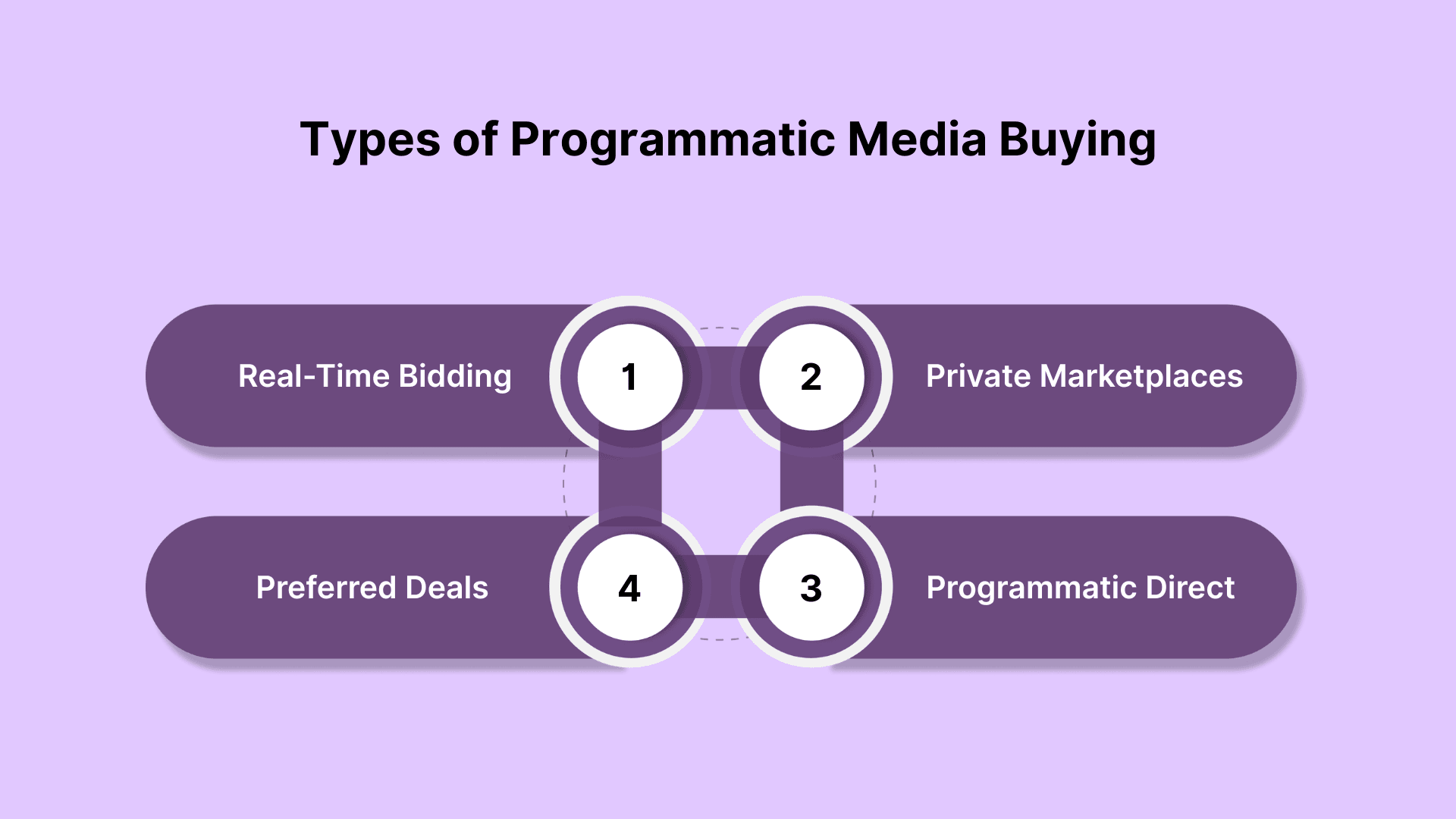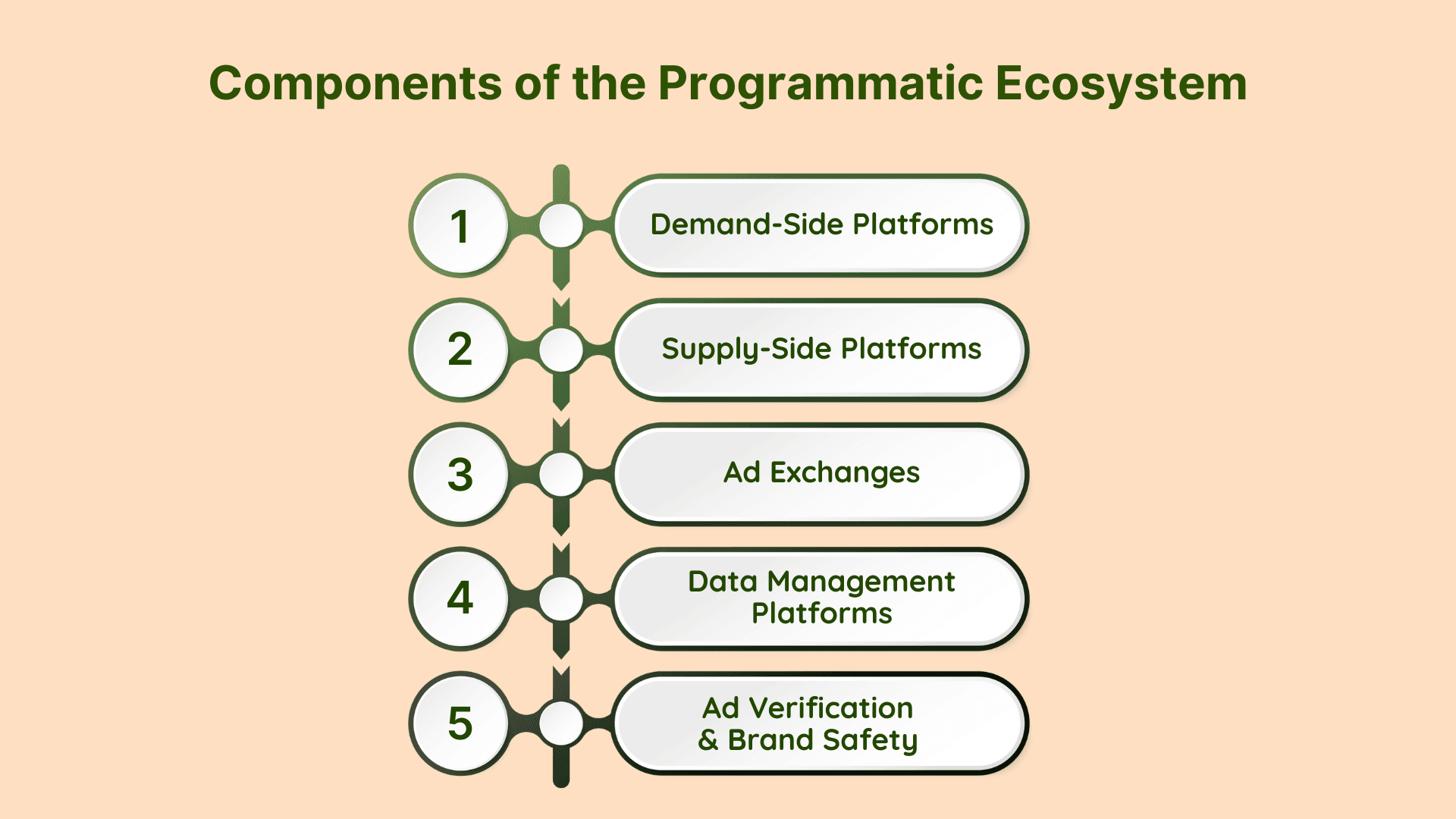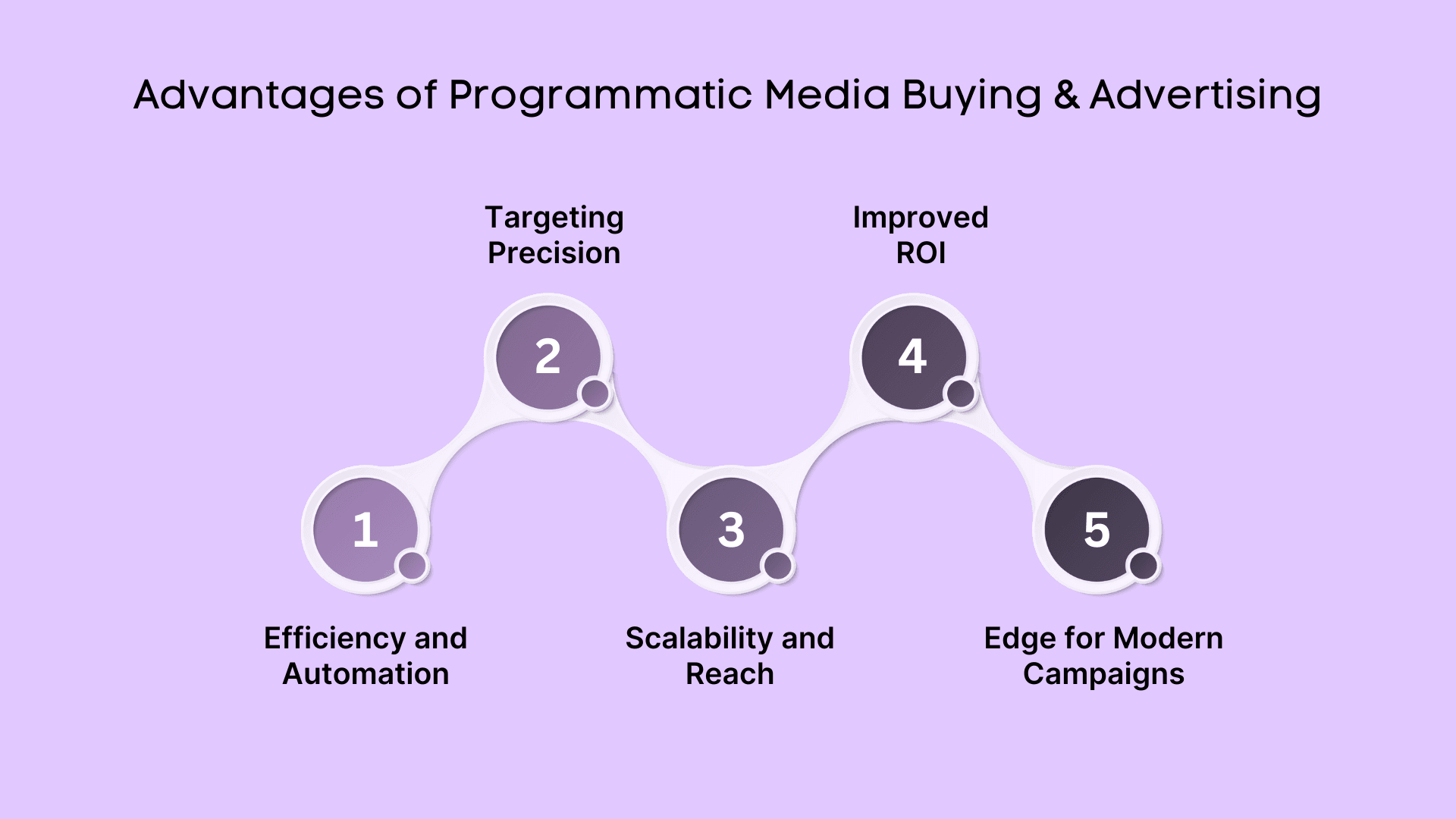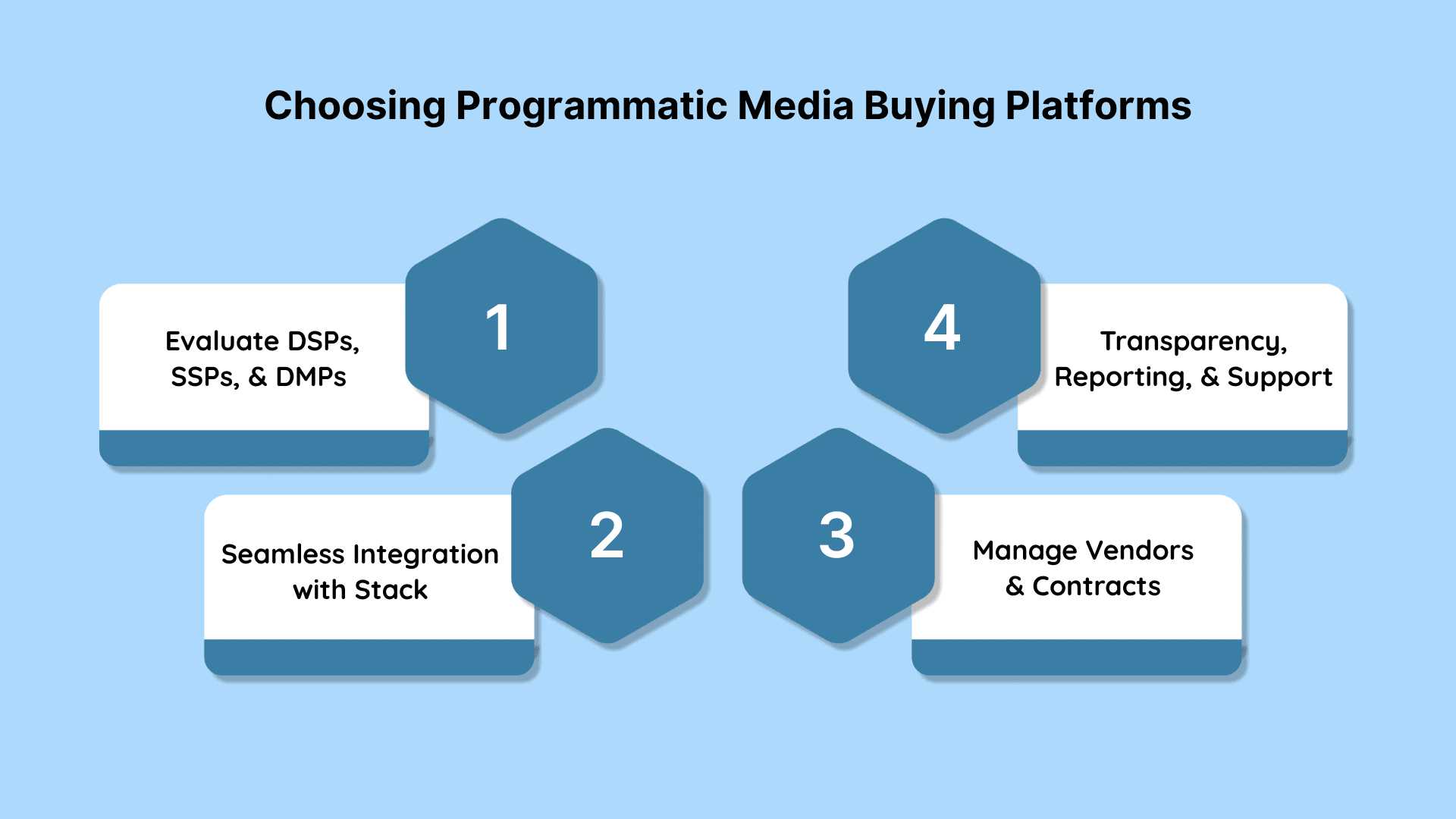A Complete Guide to Programmatic Media Buying and Advertising
Every minute spent on paperwork and platform hopping is a minute you could've used to test new creative or optimize bids. Misaligned placements lead to wasted spend, and delayed adjustments mean missing out on high-value players at critical moments.
We understand that navigating the complexities of multiple platforms and real-time bidding can feel overwhelming, especially when every moment counts toward capturing valuable players.
Programmatic media buying automates bidding, targeting, and delivery, allowing you to focus on strategy rather than logistics. By tapping into real‑time auctions across web, mobile, CTV, and audio, you deliver the right message to the right player in milliseconds and shift budgets instantly to top‑performing channels.
In this blog, you'll find a clear definition of programmatic media buying and understand why it's crucial in 2025. You'll then explore the primary buying methods, from real-time bidding to private marketplaces, and learn how to build a stack that meets your goals. Finally, you'll discover best practices for creative testing, risk management, and performance optimization to help you reach and retain more players.
What Does Programmatic Media Buying Mean?
Instead of manually negotiating every ad placement, modern buying software connects you to publishers and ad exchanges. Programmatic advertising is the automated process of buying and selling digital ad inventory. Platforms match your message to available ad slots and deliver it to a specific user in milliseconds. This automation handles bidding, targeting, and delivery, making campaigns easier to adjust on the fly.
Programmatic spend continues to grow. In the United States, programmatic advertising across web, mobile, connected TV (CTV), digital out-of-home, and digital audio reached approximately $52 billion in 2024, with CTV accounting for 28% of that spending. These numbers underscore the widespread adoption of the automated approach.
For user acquisition teams, programmatic buying offers two significant benefits. You gain access to almost all digital inventory from mobile apps and web banners to streaming video, and you can target viewers based on first‑party data, browsing behaviour, or contextual signals. This precision helps you reach gamers who are most likely to install your app. Secondly, the automation allows you to adjust bids, budgets, and creative in real-time, so you can scale what works and cut spend on underperforming impressions.
The combination of data-driven targeting and automation makes programmatic advertising a good fit for performance-focused campaigns.
Types of Programmatic Media Buying

1. Real-Time Bidding (RTB)
Real-Time Bidding is the most widely used method in programmatic media buying. In this model, each ad impression is auctioned off in milliseconds. Advertisers define their targeting rules and budget, and the highest bid wins the impression. RTB is known for its efficient targeting and transparency.
RTB continues to grow steadily, with a 19% compound annual growth rate. It works well for dynamic, cross-device campaigns such as those focused on driving game installs. But to avoid low-quality ad placements, it's essential to have strong brand safety filters in place.
2. Private Marketplaces (PMPs)
PMPs are invitation-only auctions that provide selected buyers with access to premium ad inventory. These deals offer more control than open auctions, allowing you to manage where your ads appear and ensuring better placement quality.
More than 91% of US programmatic display spend is expected to go to PMPs and programmatic direct deals. UA teams and marketers favor PMPs because they reduce exposure to made-for-advertising (MFA) websites and offer cleaner, more trusted inventory.
3. Programmatic Direct / Guaranteed
Programmatic direct, sometimes referred to as "programmatic guaranteed," enables advertisers to purchase ad space directly from publishers at a fixed price. This skips the auction process and guarantees both inventory and delivery.
With growing privacy regulations and signal loss, many advertisers are locking in direct deals for high-value placements. In 2025, Private Marketplace (PMP) and direct deals are indeed growing at a significantly faster rate compared to open exchange buying.
4. Preferred Deals
Preferred deals let advertisers see and buy inventory before it enters an auction, but without full guarantees. The price is pre-negotiated, and advertisers can choose whether to buy the impression.
This method is beneficial for key product launches or major events when you want early access to good inventory but aren't ready to commit to a complete guaranteed deal.
Core Components of the Programmatic Ecosystem

1. Demand‑Side Platforms (DSPs)
These tools let you set targeting rules, bid values, and budgets. They connect to multiple ad exchanges, enabling the purchase of impressions across websites, mobile apps, and connected TV. A Demand‑Side Platform (DSP) also integrates with a data management platform to pull in your first-party data for lookalike modeling. Leading DSPs for mobile gaming include solutions from Unity Ads, AppLovin (MAX), and ironSource LevelPlay. Use them to automate bids based on cost per install (CPI) or return on ad spend (ROAS) and to test creative quickly.
Note: While Unity Ads, AppLovin MAX, and ironSource LevelPlay offer DSP-like RTB and automated bidding, they are primarily known for mediation and SDK-based monetization; their DSP features are part of broader tool suites (e.g., Unity Audience Pinpointer, AppLovin AXON).
2. Supply‑Side Platforms (SSPs)
Supply‑Side Platforms (SSPs) are indeed tools (Sovrn, PubMatic, OpenX) that help publishers package and sell ad inventory in real time to multiple demand sources, including DSPs, ad exchanges, and networks. They optimize yield using techniques like real-time bidding and the ability to set price floors. SSPs also give publishers control over brand-safe placements by blocking unwanted ads, advertisers, or categories.
While SSPs contribute to viewable, fraud-free ad delivery by supporting industry viewability standards and integrating with fraud detection, they aren't a complete safeguard on their own. Publishers aiming for high viewability and low fraud usually layer in verification services (e.g., IAS, DoubleVerify), whitelists, and post-bid analysis for stronger protection.
3. Ad Exchanges
Ad Exchanges are digital marketplaces where:
SSPs integrate publisher inventory and push bid requests into the exchange
DSPs respond with bids in real-time auctions
The exchange mediates the auction, selects winners, and delivers ads
They support four deal types: open auctions, private marketplaces, preferred deals, and programmatic guaranteed, and offer ad formats including display, video, audio, in-app/in-game, and Connected TV. To ensure quality, they apply fraud filters, viewability standards, inventory vetting, and comply with industry brand-safety protocols.
4. Data Management Platforms (DMPs)
These systems gather and organize anonymous, cookie- or device-based data primarily from web analytics, ad IDs, and third-party sources. They create audience segments and lookalike models to target users who resemble your best players.
As third-party cookies fade, prioritize building first-party data through Customer Data Platforms (CDPs) and consider using data clean rooms to securely match and enrich data across partners. DMPs still support short-term prospecting and anonymous targeting, but for persistent, identity-based profiles, CDPs (not DMPs) are the more effective tool.
5. Ad Verification and Brand Safety
Third-party ad-verification platforms (such as DoubleVerify, Integral Ad Science, and Adloox) continuously monitor where your ads appear to safeguard your brand from both fraudulent traffic and adjacency to harmful content. A 2025 guide emphasizes that proactive, agile prevention, such as real-time filtering and dynamic suitability planning, is crucial for preventing ads from appearing alongside harmful or offensive material and for reducing ad fraud.
When selecting DSPs and SSPs, ensure they integrate with reputable verification partners and adhere to industry transparency standards, such as IAB Tech Lab's ads.txt and sellers.json. Tools like ads.txt and sellers.json help confirm authorized sellers, reducing counterfeit inventory. Emerging enhancements, such as ads.cert and SupplyChain objects, provide cryptographic verification of auction participants to further curb fraud.
Technological Foundations
1. First‑party Data & DMPs
Collecting your data is more critical than ever. As third‑party cookies disappear and privacy regulations tighten, teams need clean, accurate data to power lookalike modeling, retargeting, and user‑level targeting. Use DMPs or customer data platforms (CDPs) to unify in‑game behavior, purchase data, and CRM signals. This makes your programmatic campaigns more precise and compliant with privacy regulations.
2. Machine Learning and Algorithms
Programmatic campaigns rely on AI to analyze real‑time signals and predict which impressions will lead to valuable actions. Industry reports highlight that AI enables real-time data analysis and decision-making in programmatic advertising. In 2025, AI‑powered algorithms are expected to become more sophisticated, delivering dynamic creative and personalization in the moment. For user acquisition, that means your bids can automatically adjust based on the predicted lifetime value (LTV) of a player. AI also helps detect and filter fraudulent impressions.
The combination of data-driven targeting, automation, and precision in programmatic buying makes it an essential tool for performance-focused campaigns.
But beyond just targeting and ad placement, programmatic advertising offers several strategic advantages that help user acquisition (UA) teams scale smarter and more effectively.
Also Read: DSP vs. SSP: Understanding the Programmatic Ecosystem
Strategic Advantages of Programmatic Media Buying and Advertising

Here's how tapping into automated, data‑driven ad buying helps you move prospects through the final stages of your funnel and boost your return on ad spend:
1. Efficiency and Automation
Programmatic buying automates the entire ad‑buying workflow from real‑time bidding to placement so that you can focus on strategy instead of paperwork. Instead of negotiating with multiple publishers, an algorithm handles media purchases in milliseconds, reducing setup time and minimizing human errors. This streamlined approach frees you to optimize creativity and budgets rather than wrangling insertion orders.
Automated workflows eliminate manual tasks such as exchanging tags, troubleshooting discrepancies, and reconciling billing, reducing errors and accelerating campaign launches. Integrated buy‑and‑sell systems drive cost savings and improved accuracy, resulting in faster execution and fewer wasted impressions when you need to launch quickly and iterate based on performance.
2. Targeting Precision
You can pinpoint high‑value players by layering first‑party data, lookalike audiences, and contextual signals. Advanced AI models continuously learn which audiences deliver the most installs, then adjust bids to favor those segments. This precision targeting ensures your ads reach gamers most likely to download and play, reducing wasted spend on irrelevant impressions.
3. Scalability and Reach
Programmatic platforms integrate with thousands of exchanges, covering desktop, mobile apps, connected TV, and more. As you grow, you can scale budgets across channels with a few clicks, eliminating the need for new contracts. Whether you're testing a small campaign or pouring on scale for a launch, the system expands or contracts to match your goals, so you never miss an opportunity to reach new gamers.
4. Improved ROI
By automating bid adjustments and creative optimization in real-time, programmatic buying directs more of your budget toward placements that drive actual installs and in-game actions. Continuous performance feedback loops enable campaigns to improve over hours and days, rather than weeks, resulting in a higher return on ad spend and lower cost per install compared to manual buys.
5. Strategic Edge for Modern Campaigns
Beyond basic savings and targeting, programmatic gives you a strategic playbook to navigate today's fragmented media landscape. You gain transparency into where your ads appear, the ability to adopt industry standards like the IAB's Data Transparency Labels, and early access to emerging formats, such as programmatic CTV and live-stream ads. These advanced capabilities help you stay ahead of competitors and deliver compelling experiences to gamers across every screen.
By leveraging these advantages, you can position your campaigns to achieve your user acquisition goals and maximize revenue in 2025 and beyond.
Now that you know the advantages, let's walk through how programmatic buying works in real time from bid to ad delivery.
How Programmatic Media Buying Works in 2025
When you buy ads programmatically, you rely on real‑time systems to make buying fast and precise. Here's how it all happens:
1. Bid Request & Real‑Time Bidding (RTB)
When someone opens an app or visits a site with ad space, the publisher's supply‑side platform (SSP) instantly sends out a bid request to demand‑side platforms (DSPs). That request includes anonymized signals, such as device IDs and page context. Your DSP evaluates first‑party data (such as your user lists), cookies, and contextual cues to decide how much that impression is worth to you.
All bids occur within 100 milliseconds, and the highest offer wins the auction. The IAB Tech Lab standardizes this open RTB process to ensure transparency and consistency across platforms.
2. Ad Serving in Milliseconds
Once your bid wins, your DSP tells the SSP to serve your ad. In the same instant, the ad creative loads on the user's screen, whether it's a banner, a video, or a native placement. Because everything happens automatically, you avoid manual negotiations and the slow turnaround times that often accompany them. You only pay for the impressions that match your criteria at the exact moment they're available.
3. Precision Targeting Signals
Today's DSPs utilize a combination of cookies, device IDs, and real-time contextual signals to ensure that each impression is accounted for. With third-party cookies fading, strong first-party data, combined with machine-readable page context, ensures you reach users who look and behave like your best existing players. This approach helps maintain performance even as privacy regulations become stricter.
4. Campaign Formats You Can Mix & Match
Display Ads: Classic banners and rich media that load instantly in apps and mobile sites.
Video Ads: Short pre‑roll and in‑feed video units on social platforms and streaming apps, targeting by interest, behavior, and even time of day.
Native Ads: Seamless placements that match the surrounding content style, boosting engagement without feeling intrusive.
Because all these formats plug into the same auction pipeline, you can test and reallocate your budget across formats in real-time to maximize ROI.
5. Real‑Time Optimization & AI‑Driven Testing
You don't set and forget. Monitor key metrics, such as click-through rate (CTR), cost per acquisition (CPA), and return on ad spend (ROAS), to determine what's working. Modern AI tools can run A/B tests on multiple creative versions, automatically scale the winners, and pause underperforming ones. These real‑time adjustments cut wasted spend and push budget where it drives the most installs and revenue.
Note: Segwise is an AI‑powered solution that automates creative tagging, analytics, and testing for mobile apps and games. It integrates with major ad networks and measurement partners to track creative element performance, send real‑time alerts on underperforming variants, and surface insights that help you iterate faster and boost ROAS, all without writing code or manual tagging.
While programmatic buying offers numerous advantages, it also presents risks. Knowing how to handle them helps protect your spend and your brand.
Also Read: Creative Testing Strategies for Mobile UA Campaigns in 2025
How to Choose Programmatic Media Buying Platforms

When you're ready to finalize the components of your programmatic setup, select platforms that align with your goals, data, and budget:
1. Evaluate DSPs, SSPs, and DMPs Carefully
You want a DSP that gives you broad reach without sacrificing control. Look for platforms with access to multiple ad exchanges. More sources mean more inventory, but also a higher risk of low-quality impressions unless robust fraud filters are in place. Verify that the DSP utilizes AI-driven bidding and optimization, enabling you to respond to bid anomalies and maximize ROI in real-time. On the supply side, choose an SSP known for its premium, brand-safe inventory and flexible deal types (such as private marketplaces) to protect your budgets.
Finally, a DMP should integrate first-party and clean-room data, segment audiences on demand, and feed that insight back into your DSP to fine-tune targeting as cookieless regulations evolve.
2. Ensure Seamless Integration with Your Stack
You don't want to bolt on a new system that doesn't talk to your existing tools. Confirm API availability and pre‑built connectors for your CRM, analytics platforms, and data warehouses. Platforms that support cross-channel data ingestion allow you to unify performance metrics across mobile, display, video, and CTV in one dashboard, so you spend less time reconciling reports and more time optimizing campaigns.
3. Manage Vendors and Contracts Strategically
You should negotiate clear service-level agreements that cover uptime, support response times, and data ownership and control. Determine whether a managed service offering or a self-service model best suits your team's expertise and hands-on needs. Watch out for hidden fees; some platforms charge additional percentages on media spend or require minimum monthly commitments. Spell out any volume discounts or platform‑usage tiers in your contract so there are no surprises when you scale.
4. Prioritize Transparency, Reporting, and Support
With advertising fraud and signal loss on the rise, you need complete visibility into where your impressions are running and how bids are performing. Choose platforms that offer real‑time dashboards, anomaly alerts, and detailed breakdowns by exchange, placement, and creative. Ensure your vendor commits to regular strategy reviews and has a knowledgeable support team that you can reach via chat, email, or phone, especially during critical launch windows.
By following these four straightforward steps, you'll incorporate the right DSPs, SSPs, and DMPs into your system, secure fair contracts, and maintain complete transparency, enabling you to confidently grow your programmatic media buying in 2025.
Challenges and Risk Management in Programmatic Media Buying
When using programmatic media buying for campaigns, it is essential to have robust risk controls and sound practices in place to protect your results and brand. Here's what matters most:
1. Ad Fraud: Types, Detection, and Prevention
You need to watch for invalid traffic, such as bots generating fake impressions or clicks, and domain spoofing, where low-quality sites attempt to masquerade as premium publishers. To detect fraud, enable Programmatic limited-ads modes, such as Google Ad Manager's "limited ads" setting, activate cookies that help detect invalid traffic by identifying non-human or fraudulent activity, thereby improving ad quality and reducing wasted spend.
Next, plug into third-party verification tools such as IAS (AI-driven media quality data) or DoubleVerify (impression-level metrics) that continuously scan for anomalies. Finally, insist on partners who support ads.txt and sellers.json. These IAB standards greatly limit the ability of fraudsters to sell counterfeit inventory.
2. Brand Safety: Avoiding Unsuitable Placements
You don't want your creative appearing next to controversial or off‑brand content. Start by defining your suitability rules block categories, such as hate speech or adult themes, and apply them through your DSP's brand-safety controls. Many platforms now offer AI-driven risk assessments that flag questionable pages in real-time.
As a next step, layer on human review of flagged placements and set up automated blocklists that update hourly. When you're ready to scale, look for programs certified by the IAB's "Quality Assurance" initiative to guarantee ongoing compliance.
3. Privacy Compliance: Navigating Global Rules
Data privacy laws are constantly evolving, and failing to comply can result in delayed spending or fines. In the US, regulations such as the California Privacy Rights Act and the upcoming Minnesota Consumer Data Privacy Act grant users rights over their data, including access, correction, deletion, and the ability to opt out of profiling.
Implement a consent-management platform that supports the IAB Transparency and Consent Framework (TCF) v2.2, and ensure your tags respect each user's individual choices. Finally, run quarterly audits of your data flows to track where personally identifiable information (PII) is stored, how long it is retained, and with whom it is shared, ensuring you remain audit-ready and maintain user trust.
4. Platform Complexity: In‑House vs. Managed Service
As you grow, you'll weigh the control of a self‑serve DSP against the expertise of a managed service. Self‑serve gives you direct access to settings and real‑time tweaks, but it takes time to master bid strategies and reporting dashboards. A managed service can fast‑track optimization and handle day‑to‑day monitoring, though you'll pay a fee on top of media spend. To decide, map out your team's bandwidth and skill set: if you already have data analysts and campaign managers in place, self-serve may be a more cost-effective option. If you need quick turnaround and expert support, lean on a managed partner.
Staying ahead means striking a balance between opportunity and caution. If you plan for risks and choose the proper setup, programmatic media buying can play a pivotal role in optimizing your UA strategy.
Also Read: How AI Is Revolutionizing Mobile User Acquisition in 2025
Conclusion
Programmatic media buying combines precise audience insights and automated decision-making to maximize the impact of every dollar. By tapping into first-party data, such as in-game behavior and past purchase history, alongside contextual signals like time of day and device type, you ensure your ads reach players most likely to install and engage. At the same time, automated bidding and creative testing engines continually evaluate which headlines, visuals, and placements yield the best results, instantly shifting the budget toward top performers.
This combination of real‑time adjustments, data layering, and ongoing performance feedback not only reduces wasted impressions but also accelerates your ability to scale campaigns, refine messaging, and hit user acquisition targets more efficiently.
Ready to streamline your programmatic creative testing and maximize ROAS? Start a 14‑day free trial.
FAQs
1. How do you know if your programmatic campaigns are working?
You track key metrics, such as cost-per-install (CPI), installs per thousand (IPM), and return-on-ad-spend (ROAS), to see which placements and creatives drive the best performance.
2. Which ad formats usually win in programmatic for games?
You'll often get the best engagement from interactive formats, playable ads, and short looping videos, as they allow players to try your game before installing it.
3. How have privacy changes like SKAdNetwork affected programmatic UA?
You need to adapt your measurement and bidding strategies, given IDFA limits and SKAdNetwork's delayed reporting, which rely more on aggregate signals and LTV modeling to guide your spend.
4. How long before you see real results from a programmatic test?
You should start optimizing after about a week of live data, with initial bids and budgets in place. Run small tests, then scale up on winning segments once you hit performance benchmarks.
5. How many ad creatives should you test at once?
You should start by testing around 3–5 different creatives simultaneously, enough to identify a winner quickly without overextending your budget. Once you find the top performer, pause the underperformers and introduce new variations to keep the results fresh.

Comments
Your comment has been submitted successfully!